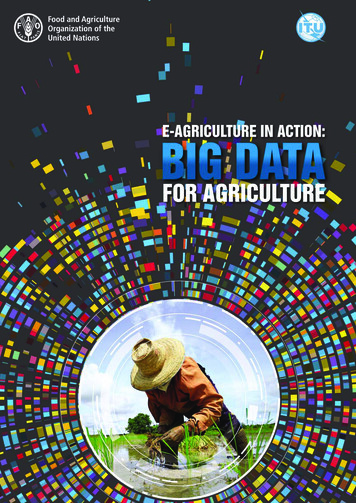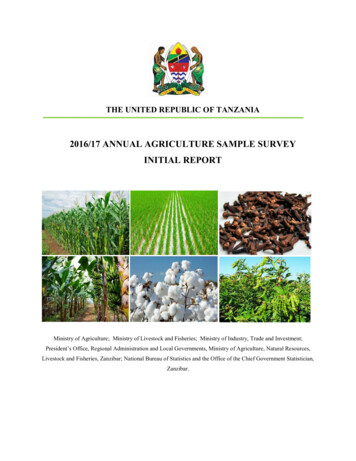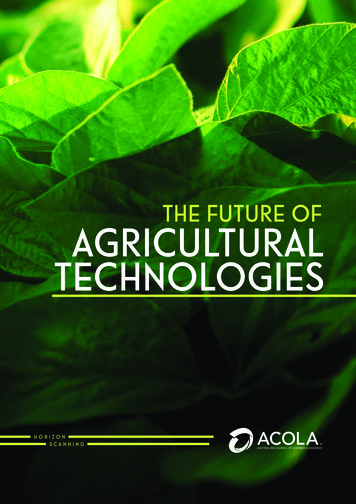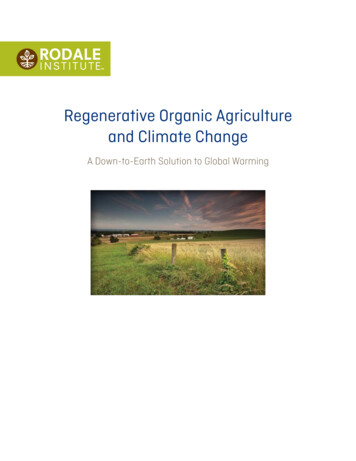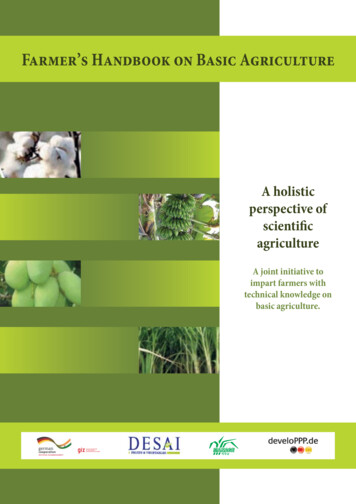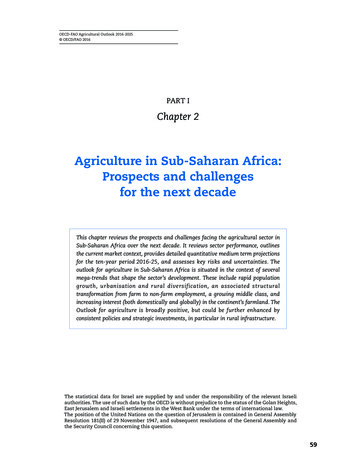
Transcription
OECD-FAO Agricultural Outlook 2016-2025 OECD/FAO 2016PART IChapter 2Agriculture in Sub-Saharan Africa:Prospects and challengesfor the next decadeThis chapter reviews the prospects and challenges facing the agricultural sector inSub-Saharan Africa over the next decade. It reviews sector performance, outlinesthe current market context, provides detailed quantitative medium term projectionsfor the ten-year period 2016-25, and assesses key risks and uncertainties. Theoutlook for agriculture in Sub-Saharan Africa is situated in the context of severalmega-trends that shape the sector’s development. These include rapid populationgrowth, urbanisation and rural diversification, an associated structuraltransformation from farm to non-farm employment, a growing middle class, andincreasing interest (both domestically and globally) in the continent’s farmland. TheOutlook for agriculture is broadly positive, but could be further enhanced byconsistent policies and strategic investments, in particular in rural infrastructure.The statistical data for Israel are supplied by and under the responsibility of the relevant Israeliauthorities. The use of such data by the OECD is without prejudice to the status of the Golan Heights,East Jerusalem and Israeli settlements in the West Bank under the terms of international law.The position of the United Nations on the question of Jerusalem is contained in General AssemblyResolution 181(II) of 29 November 1947, and subsequent resolutions of the General Assembly andthe Security Council concerning this question.59
2.AGRICULTURE IN SUB-SAHARAN AFRICA: PROSPECTS AND CHALLENGES FOR THE NEXT DECADEIntroductionThe Sub-Saharan Africa1 (SSA) region accounts for more than 950 million people,approximately 13% of the global population. By 2050, this share is projected to increase toalmost 22% or 2.1 billion. Undernourishment has been a long-standing challenge, withuneven progress across the region. Despite being reduced from 33% in 1990-92 to 23%in 2014-16, the percentage of undernourishment remains the highest among developingregions (FAO, IFAD and WFP, 2015). Owing to rapid population growth of 2.7% p.a. over thesame period, the absolute number of undernourished people has increased by 44 million toreach 218 million. Slow progress towards food security has been attributed to lowproductivity of agricultural resources, high population growth rates, political instabilityand civil strife. However, vast regional differences remain and the success achieved incountries with stable political conditions, economic growth and expanding agriculturalsectors suggests that appropriate governance systems, institutional capacities, and macroeconomic, structural and sectoral policies can work together to improve food security on along-lasting and sustainable basis.The important role of the agricultural sector in contributing to food security isreflected in its prioritisation in the development agenda. The Comprehensive AfricanAgricultural Development Programme (CAADP) is an integral part of the New Partnershipfor Africa’s Development (NEPAD) and the sector’s prominence in the region is evident inits contribution to total GDP, which is generally high in the global context. The highcontribution of the agricultural sector to GDP also underlines the limited diversification ofmost African economies. On average, agriculture contributes 15% of total GDP, however itranges from below 3% in Botswana and South Africa to more than 50% in Chad (Figure 2.1),implying a diverse range of economic structures. Agriculture employs more than half of thetotal labour force (IMF, 2012) and within the rural population, provides a livelihood formultitudes of small-scale producers. Smallholder farms constitute approximately 80% ofall farms in SSA and employ about 175 million people directly (Alliance for a GreenRevolution in Africa, 2014). In many of the countries, women comprise at least half of thelabour force (FAO, 2015).Given its role in confronting the challenge of eradicating hunger and improving foodsecurity, this chapter considers the historic performance and current state of agriculture inSSA, within the context of the region’s political and economic conditions, natural resourcesituation and demographic structure. It acknowledges the role of policies and megatrends2in shaping development of the agricultural sector. Megatrends include demographicchange, the rise of the African middle class, growing access to new information andcommunication technologies, rapid urbanisation and consequent shifts in food demand.This is accompanied by downstream modernisation of food systems, a considerable shiftin the labour force from farming to nonfarm jobs, and rising global interest in availableAfrican farmland strengthened by the sharp rise in agricultural commodity prices over thepast decade.60OECD-FAO AGRICULTURAL OUTLOOK 2016-2025 OECD/FAO 2016
2.AGRICULTURE IN SUB-SAHARAN AFRICA: PROSPECTS AND CHALLENGES FOR THE NEXT DECADEFigure 2.1. Agriculture as a share of total GDP in 2014%6050403020Rest of the wanaSouth straliaEuropean UnionUnited States0Canada10Sub-Saharan AfricaNote: DRC refers to Democratic Republic of the Congo.Source: World Bank (2016).1 2 http://dx.doi.org/10.1787/888933381341These megatrends are not inevitable and remain subject to a degree of uncertainty aswell as future policies. The focus on SSA as a whole risks perpetuating a view of Africa asa single entity, however this chapter aims to provide an agricultural outlook, with a widerconsideration of links to growth and food security, that reflects the complexity within theregion.The agricultural environment in Sub-Saharan AfricaAfter decades of stagnation, much of Africa is now experiencing rapid economictransformation. In the post-structural adjustment period, the business environment hasbecome more stable and albeit from a small base, the region has experienced rapideconomic growth since the mid-1990s. These domestic factors in combination with theglobal “commodity boom” enabled commodity exporting countries in particular to achievegrowth rates above or near 6%. However, the recent decrease in agricultural commodityprices, lower demand arising from China and currency depreciation have tempered growthrates in African economies. Foreign investment and external financial flows into Africahave quadrupled since 2000. These flows are expected to increase further in the comingyears (AfDB, OECD & UNDP, 2014),3 while internally generated funds in the form of taxrevenues continue to rise across the continent.Drivers of agricultural growthEvident from its high share in GDP (Figure 2.1), the prospects of the agricultural sectorheavily influence economic development in most countries in Sub-Saharan Africa.From 1990 to 2013, the total value of agricultural production, measured in constant USdollars, increased by 130% (Figure 2.2). The crop sector dominates total agriculturalproduction value, accounting on average for almost 85% of total production value over the24-year period. This share differs across the region, ranging from 53% in Southern Africa,to more than 90% in Western Africa.OECD-FAO AGRICULTURAL OUTLOOK 2016-2025 OECD/FAO 201661
2.AGRICULTURE IN SUB-SAHARAN AFRICA: PROSPECTS AND CHALLENGES FOR THE NEXT DECADEFigure 2.2. Gross agricultural production value in Sub-Saharan AfricaMeasured in constant 2004-06 US DollarsAgriculture growth rateCrops indexLivestock indexAgriculture indexIndex (2005 100)140%121012081006804602040-2200-41990 1991 1992 1993 1994 1995 1996 1997 1998 1999 2000 2001 2002 2003 2004 2005 2006 2007 2008 2009 2010 2011 2012 2013-6Source: FAOSTAT (2016), FAO, http://faostat3.fao.org/.1 2 http://dx.doi.org/10.1787/888933381351Regional differences in the relative contribution of the crop and livestock sub-sectorsreflect agro-ecological and cultural diversity. Significant growth was evident across SSAover the past 24 years, but Western Africa continues to account for more than 60% of thetotal value of agricultural output in SSA, while Southern Africa contributes 22%. WesternAfrica has also been the greatest driver of volatility in total production value since 2007(Figure 2.2), mainly due to volatile yam production in Nigeria. Despite the diversity in cropmix across the region, the crop sector’s share of total production value is significantlyhigher in all sub-regions except Southern Africa, where the shares of livestock and cropproduction value are similar.Within each of the four sub-regions, the five biggest crops contribute more than 45%of total crop production value, with maize being the single most important staple crop. Riceis an important staple in Eastern and Western Africa, and other important staples includepotatoes (Eastern and Central Africa), sweet potatoes (Eastern Africa), cassava (Westernand Eastern Africa) and plantains (Eastern and Central Africa). In Southern Africa, thestrong share of fruits and vegetables in total value of production is due to South Africa’sexport oriented horticultural production.The livestock production mix exhibits similar diversity, not only in its contribution tothe total value of agricultural output, but also to the relative importance of the differentlivestock subsectors. Poultry contributes a substantial share of livestock production valueacross the region, ranging from 12% in Eastern Africa to 45% in Central Africa and SouthernAfrica (Figure 2.4). Interestingly in Central Africa, where livestock production value issmaller than any of the other three regions, game meat accounts for 35% of livestock value.Livestock production systems remain largely extensive, with pasture based ruminantproduction often the only system able to add value in semi-arid areas. Often the movementof livestock in line with seasonal changes and fodder availability remains the only way ofsecuring feed for large herds (NEPAD, 2014). At the same time, vertically integrated,intensive poultry operations that link commercial feed grain producers to feed mills,62OECD-FAO AGRICULTURAL OUTLOOK 2016-2025 OECD/FAO 2016
2.AGRICULTURE IN SUB-SAHARAN AFRICA: PROSPECTS AND CHALLENGES FOR THE NEXT DECADEFigure 2.3. Crop mix across the Sub-Saharan African regionBased on average value of production 2011-13CerealsOther Cash CropsOilseedsRoots and tubersPulsesFruit and vegetables%1009080706050403020100Eastern AfricaCentral AfricaSouthern AfricaWestern AfricaSource: FAOSTAT (2016). FAO, http://faostat3.fao.org/.1 2 http://dx.doi.org/10.1787/888933381368Figure 2.4. Livestock mix across the Sub-Saharan African regionBased on average value of production 2011-13OtherPoultryPorkSheep and GoatBeefDairy%1009080706050403020100Eastern AfricaCentral AfricaSouthern AfricaWestern AfricaSource: FAOSTAT (2016), FAO, http://faostat3.fao.org/.1 2 http://dx.doi.org/10.1787/888933381371abattoirs and wholesalers have been evident for many years in some countries (such asSouth Africa) and have recently started expanding in others (such as Zambia andTanzania). Such operations target urban consumption centres characterised by rapidgrowth in food demand.Fisheries and aquaculture also make a multifaceted contribution to nationaleconomies in SSA. The region has vast fish resources, in marine and inland waters, and ischaracterised by diverse fishing communities. Small and industrial-scale fishing targets adiverse array of species for local and international consumption. Benefits generated by theOECD-FAO AGRICULTURAL OUTLOOK 2016-2025 OECD/FAO 201663
2.AGRICULTURE IN SUB-SAHARAN AFRICA: PROSPECTS AND CHALLENGES FOR THE NEXT DECADEsector include nutrition and food security, livelihoods, employment, and foreign revenue.Similarly to other agricultural sub-sectors, fisheries and aquaculture are considered to beunderutilised, despite inherent potential. Total fishery production in the region representsonly about 4% of world production and growth prospects are limited in the next decade.Fisheries and aquaculture in SSA faces enormous challenges and deficiencies which arelimiting the capability of most governments to ensure its sustainability and profitability.Challenges include inadequate management of fish stocks; lack of knowledge and evidenceto foster reforms; untapped potential of small-scale fisheries; weak and uncoordinatedinstitutions; limited or ineffective institutional and legal frameworks; weak scientificresearch; inadequate human and financial resources; lack of reliable, relevant and timelyinformation; lack of adequate infrastructure and services; and climate change, which isexpected to change future fisheries production patterns, as species move to new habitats.Agricultural growth has been underpinned by area expansionThe African model of agricultural growth differed significantly from that of Asia or SouthAmerica. In Asia, growth was driven largely by intensification, whereas in South America, itwas the result of significant improvement in labour productivity arising from mechanisation.By contrast, strong growth in SSA agricultural output has accrued predominantly from areaexpansion and intensification of cropping systems, as opposed to large-scale improvement inproductivity (NEPAD, 2014; Brink and Eva, 2009). While the agricultural labour force hasexpanded, NEPAD (2014) notes that productivity per agricultural worker has improved by afactor of only 1.6 in Africa over the past 30 years, compared to 2.5 in Asia.Given that SSA is generally regarded as land abundant, continued area expansion inthe coming decade may not seem problematic. However rural SSA is highly heterogeneousand while much of its land is unutilised or underutilised, a considerable share of its ruralpopulation resides in smallholder farming areas that are densely populated and face landshortages (Jayne et al., 2014). In a wider assessment that considers a combination ofbiophysical and economic factors as criteria for viability, Chamberlin et al. (2014) indicatethat potentially arable cropland is highly sensitive to assumptions related to landproductivity and market access. Much of the underutilised land is concentrated inrelatively few countries and between one half and two thirds of surplus land is currentlyunder forest cover. Conversion of such forest land to agriculture would come atconsiderable environmental cost.In land constrained countries, area driven growth may come at the expense of fallows.Rising rural populations and associated land pressures has resulted in continuouscropping in many African countries, with fallows largely disappearing in denselypopulated areas.4 Continuous cultivation of existing plots would not necessarily poseproblems for sustainable intensification if sufficient use of fertilisers, soil amendmentpractices and other land-augmenting investments are employed and coupled withcontinued education to maintain and improve soil quality. However, a large body ofliterature in SSA points to soil degradation arising from unsustainable cultivation practicesin regions with a high population density, for example parts of Kenya and Malawi(Stoorvogel and Smaling, 1990; Drechsel et al., 2001; Tittonell and Giller, 2012). Continuouscultivation and lack of crop rotation deplete organic carbon levels, making soil lessresponsive to fertiliser application. This also makes it more difficult for smallholderfarmers to benefit from yield gains offered by plant genetic improvement.64OECD-FAO AGRICULTURAL OUTLOOK 2016-2025 OECD/FAO 2016
2.AGRICULTURE IN SUB-SAHARAN AFRICA: PROSPECTS AND CHALLENGES FOR THE NEXT DECADEAgriculture’s contribution to employmentThe agricultural sector has a pivotal role in employment in SSA, employing more than halfof the total workforce. While its importance to the rural population is well documented, recentsurveys suggest that agriculture is also the primary source of livelihood for 10% to 25% of urbanhouseholds. National census data indicates that the number of people employed primarily inagriculture has increased over time (Yeboah and Jayne, 2015).As a consequence of rapid population growth, SSA has a young population, which willresult in about 17 million people entering the labour force annually over the next decade(Losch, 2012; IMF, 2015). Given current employment growth rates, less than half will beabsorbed into gainful non-agricultural employment and even under more favourable policyand growth scenarios, the share rises to two thirds at most (Fine et al., 2012). Consistent withemployment trends by the Groningen Global Development Centre (2013), the World Bankreports that family farming will remain the single largest source of employment in the comingdecade (Filmer and Fox, 2014). Thus youth participation in agriculture will largely depend onthe viability of family farming.Innovative ways of facilitating youth participation in agriculture have the potential todrive widespread poverty reduction among youths and adults alike. A coherent and integratedapproach that addresses challenges related to education, land access and tenure, access tofinancial services, access to markets, access to green jobs and involvement in policy dialoguehas the potential to make the agricultural sector more attractive to young people, providing theadditional push that may be needed for them to enter the sector (FAO, CTA and IFAD, 2014).The potential for urbanisation and income growth to stimulate job expansion indownstream segments of the food system also depends on where the primary agriculturalproducts come from. Faster growth in domestic production arising from commercialisationcould generate job growth in food assembly, wholesaling, processing and retailing. Box 2.1provides further detail on the emergence of the West African food economy and the role ofvalue addition in creating employment opportunities.Box 2.1. Emergence of a West African food economyWest Africa’s cities are now home to 133 million people, 25 times more than in 1950. Between 2000and 2010 alone, the urban population grew by over 48 million people. Consequently, the size of the foodeconomy grew spectacularly. Bolstered by urbanisation and income growth, household food consumptionpatterns are changing and the food economy is developing.A growing number of households are turning to markets for their food supply. In urban areas, almost allfood is bought on the market with an average of 93% of household food consumption supplied through variousdistribution channels. At the same time, increasingly diversified rural economies and the spread of urbanproducts and lifestyles mean that the share of rural food supply from markets is also growing. Overall, marketsprovide at least two-thirds of household food consumption at the regional level (OECD, 2013).Urbanisation and urban lifestyles are also accompanied by shifts in dietary patterns, which are spreadingbeyond the frontiers of towns and cities. More fruits, vegetables and processed foods are being consumed,while the share of cereals and pulses is declining. Urban consumers are clearly moving towards highervalue food products. Fruits and vegetables, and meat and fish now account for half of the total foodexpenditure by urban households. The demand for convenience is an overarching trend across incomegroups and area. This is reflected in the strong demand for processed and prepared foods and in theexpansion of street food. In urban areas, processed foods represent 41% of food budgets. Rural households,although less than their urban counterparts, still spend 36% of their budget on processed foods (Figure 2.5).OECD-FAO AGRICULTURAL OUTLOOK 2016-2025 OECD/FAO 201665
2.AGRICULTURE IN SUB-SAHARAN AFRICA: PROSPECTS AND CHALLENGES FOR THE NEXT DECADEBox 2.1. Emergence of a West African food economy (cont.)Figure 2.5. West African food basket by food groups and area in 2010UrbanRuralBeverages5%Beverages4%Fruit andvegetables27%Fruit andvegetables31%Dairy4%Other12%Other13%Dairy2%Meat and Fish16%Meat and %Unprocessed34%Unprocessed26%Source: Global Consumption Database, World Bank; SWAC/OECD.1 2 http://dx.doi.org/10.1787/888933381386The combined effects of rapid urbanisation, population growth and resulting transformations in fooddemand have had major impacts on the size of the West African food economy and its structure. Usingrecent expenditure and consumption surveys compiled by the World Bank, the size of the West Africanfood economy is estimated at USD 178 billion in 2010.1 This represents 36% of regional GDP, making it thelargest sector of the West African economy. In many countries, the domestic food market is becoming moreattractive for farmers than traditional export cash crops. The non-agricultural postharvest activities of thefood economy, such as processing, logistics and retail, are developing quickly. These account for 40% of thesector’s value added and will continue to expand (Allen and Heinrigs, 2016).The emergence of local food industries and processing facilities creates increasing employmentopportunities in processing, packaging, distribution and retail in urban and rural areas. In many rural areasthe non-farm rural economy is growing rapidly and driving economic transformations.66OECD-FAO AGRICULTURAL OUTLOOK 2016-2025 OECD/FAO 2016
2.AGRICULTURE IN SUB-SAHARAN AFRICA: PROSPECTS AND CHALLENGES FOR THE NEXT DECADEBox 2.1. Emergence of a West African food economy (cont.)To fully leverage the opportunities associated with urbanisation and the development of the foodeconomy, a refocusing of agricultural policy towards an integrated food policy is needed. Supportingfarmers in satisfying urban demand for fruits and vegetables, and meat and fish needs to be complementedby improving the business environment for agro-food businesses in processing, distribution and retail, andby improving the connections between urban areas and their rural hinterlands.1. Calculated as the sum of all food consumption and adjusted by GDP figures.Agricultural policies in Sub-Saharan AfricaMotivated by the need for a vibrant and sustainable agricultural sector, a number ofpolicy initiatives have been integral to the sector’s development over the past decade.CAADP was prioritised within the 2003 Maputo Declaration on Agriculture and FoodSecurity through commitments to allocate at least 10% of national budgetary expendituretowards its implementation and aimed to achieve a 6% annual growth of the agriculturalsector. Less than 20% of countries have achieved their commitment on agriculturalspending. More recently, these commitments were reaffirmed in the Malabo5 declarationon accelerated agricultural growth, which pledged to end hunger in Africa by 2025.Despite the prioritisation of the agricultural sector, FAO’s Monitoring and AnalysingFood and Agricultural Policies (MAFAP) programme notes an overall decreasing trend in theshare of public resources channelled to agriculture in the ten countries reviewed in 2013.6These countries have spent public funds on a broad range of consumer and producersupport policies (Figure 2.6). However, some of these expenditures may have targetedprimarily short-term objectives that may not have been fully aligned with long-termdevelopment goals for the sector (AfDB, FAO and ECOWAS, 2015). The strategicdevelopment of the agricultural sector would benefit from increased policy focus onFigure 2.6. Public expenditure on the agricultural sector in selectedSub-Saharan African countriesOtherStorage and marketingAgricultural infrastructuresKnowledge disseminationAgricultural researchInput subsidies%1009080706050403020100Burkina awiMozambiqueSource: Angelucci et al. (2013).1 2 http://dx.doi.org/10.1787/888933381397OECD-FAO AGRICULTURAL OUTLOOK 2016-2025 OECD/FAO 201667
2.AGRICULTURE IN SUB-SAHARAN AFRICA: PROSPECTS AND CHALLENGES FOR THE NEXT DECADEinfrastructure, research and development. A lack of stability in the political and policyframework has been identified by numerous researchers as a constraining factor to thesector’s development. Consistency of policy applications will remain a key factor shapingthe success of the sector within the development agenda.As a form of producer support targeting improved productivity, fertiliser subsidyprogrammes have been employed in a number of countries and while successful inaccelerating yield growth in countries such as Zambia and Malawi, the ultimateeffectiveness of such programmes in the long-run remains disputed, with the costs oftenfound to outweigh the benefits (Jayne and Rashid, 2013). As an alternative, a holisticapproach to support small-scale producers has been encouraged. This includes investmentin agricultural R&D, extension programmes focused on improved soil quality and physicalinfrastructural development.The establishment of strategic food reserve systems to support food security was aresolution within the Maputo declaration on agriculture and food security. Consequentlymost of the funds allocated to consumer related programmes in the region have been spenton maintaining public food stocks of important staple grains. The implementation costs, aswell as the price distorting impacts of such policies are important considerations. Theyhave been minimised where their application is based on transparent target prices that arein line with import and export parity levels. Additionally, governments used temporarytrade policies such as export bans or import tariff reductions to support consumers.Production growth in SSA has failed to keep pace with demand deriving frompopulation and income growth, resulting in rising imports for food commodities such aswheat, rice and poultry. In many instances, import tariffs have been employed to supportdomestic producers, particularly relative to other producers outside the region. Box 2.2illustrates some of the possible benefits from increased intra-regional trade in Eastern andSouthern Africa. Multiple regional trade agreements in Africa, such as the Common Marketfor Eastern and Southern Africa (COMESA), the East African Community (EAC), theEconomic Community of West African States (ECOWAS) and the Southern AfricanDevelopment Community (SADC), have been successful in reducing tariff rates, but havealso been accompanied by a commensurate rise in non-tariff measures. Implementation ofthe tripartite free trade area, established in 2015 between SADC, COMESA and the EAC willresult in the largest economic bloc on the continent, covering more than 50% of Africa’spopulation and GDP, it has the potential to impact significantly on trade in the region.Box 2.2. The role of intra-regional trade in reducing market volatilityand improving food security across Eastern and Southern AfricaHigh domestic food price volatility has been a recurring issue in many African countries. It poses aparticular risk to the food security of poor households that spend a greater share of their income on foodand for households depending on agriculture for their livelihood. The perceived need by governments tostabilise volatile prices and supply has long motivated their interventions in agricultural markets, despitethe international drive towards liberalisation (Jayne and Tschirley 2009, Minot 2014). In reacting to thesemarket shocks, governments are often faced with the need to balance short-term food security objectiveswith the longer term goal of raising productivity growth. In SSA, the most food insecure region in the world,achieving this balance remains a challenge, yet consistent policy application remains critical.68OECD-FAO AGRICULTURAL OUTLOOK 2016-2025 OECD/FAO 2016
2.AGRICULTURE IN SUB-SAHARAN AFRICA: PROSPECTS AND CHALLENGES FOR THE NEXT DECADEBox 2.2. The role of intra-regional trade in reducing market volatilityand improving food security across Eastern and Southern Africa (cont.)The role of intra-regional trade in reducing volatility and improving food security was recognised by theAfrican Union (AU) in its Malabo Declaration on accelerated agricultural growth, which committed toboosting intra-African trade in agricultural commodities and services. Reductions in barriers to regionaltrade offer an inexpensive means of reducing domestic prices and hold enormous potential to improvefood security in the region. This positive contribution is already evident in regions where neighbouringcountries are pooling production to stabilise markets through cross border trade (Mozambique-Malawi,Malawi-Zambia, Uganda-Kenya) (Chapoto and Sitko, 2014).The emergence of Zambia as a consistent surplus producer, particularly for maize, has resulted inchanging regional trade patterns in Eastern and Southern Africa. A favourable transport differential andthe absence of genetically modified (GM) technology have made it the preferred source for Zimbabweanimports. At the same time, discretionary trade restrictions from the Zambian government haveinfluenced the consistency of supply into Zimbabwe, impacting on price volatility. Over the course of theOutlook projection, the extent to which Zambia continues to grow as an exporter into Zimbabwe andother deficit countries in the region will depend on the consistency with which its trade policies areapplied. South Africa and Uganda have maintained open trade policies and are projected to continuesupplying exports consistently into the region. Assuming that borders remain open, Zambia is alsoprojected to expand exports, becoming the second largest maize exporter in SSA in the coming decade(Figure 2.7).While intraregional trade in maize is higher, it still accounts for less than 10% of total trade in foodstaples. Informal trading charges, burdensome border regimes and limited transportation infrastructurehave all been identified as impediments. Priority should be given to acti
over the past 24 years, but Western Africa continues to account for more than 60% of the total value of agricultural output in SSA, while Southern Africa contributes 22%. Western Africa has also been the greatest driver of volatility in total production value since 2007 (Figur



